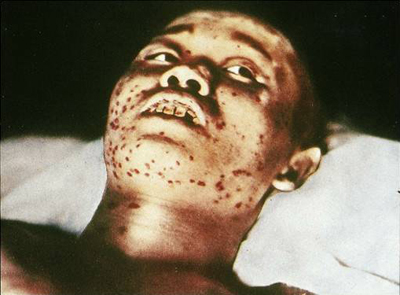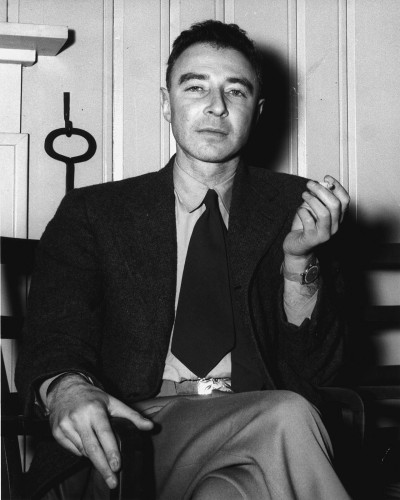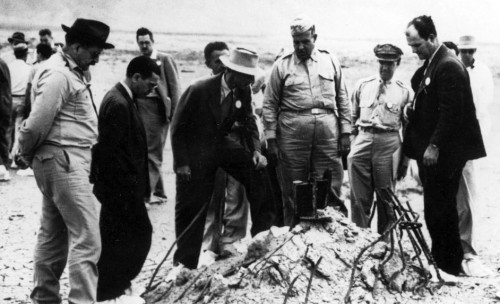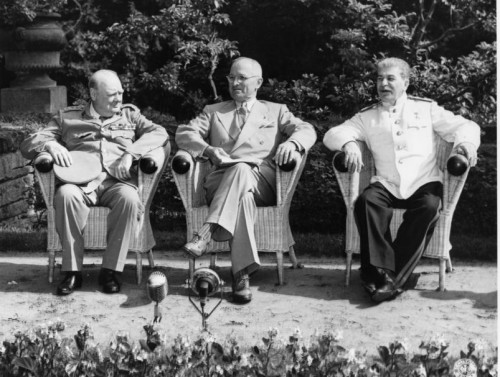Historians of science love “who knew what, and when?” question in science. We like to do so, in part, because the results are often so counterintuitive when compared with the “traditional” narratives: Mendel wasn’t really a Mendelian, Darwin’s novelty is often quite overstated, and even superficially straightforward questions like, “when was the electron discovered?” yield a considerable amount of debate about how one knows when the existence and identity of a fundamental particle is “discovered.”1 They rarely have answers that come in the form of names and exact dates. In fact, they usually show you something deeper about the way knowledge is produced, circulated, and agreed-upon at any given time in history.
Of all the many questions and sub-questions about the bombings of Hiroshima and Nagasaki, one of the ones that occasionally comes up is, “How much was known about the radiation effects of the first atomic bombs before the bombing of Hiroshima and Nagasaki?” Did Harry Truman know, for example, that the bombs would produce both prompt and residual radiation? Would it have changed his decision to use the bomb?

21-year-old soldier at Nagasaki, suffering from what was known as “Disease X” to the Japanese doctors before its identification as radiation poisoning. It took him a little under a month to die from the effects; click the image for the unpleasant details.
The reason it might matter is because arguably the radiation effects of the first atomic bombs are what distinguish them from “traditional” incendiary raids — i.e., the firebombing that had already been going on for quite some time before the Second World War went nuclear. (I personally don’t think they do, from an ethical standpoint, but I’ll be writing an entire post on this very soon, so let’s put that question to the side for now.)
Truman didn’t feel it was appropriate to use chemical or “poison” warfare — so perhaps, the argument goes, if he had thought about the atomic bombs not just as “big fire bombs” but instead as “big fire bombs with poison” he would have considered them an inappropriate weapon to actually use on cities inhabited primarily by non-combatants.
This is an interesting question, and one that would take a lot of careful work to answer. So I was really glad that Sean Malloy, an historian at UC Merced and the author of a great biography of Henry L. Stimson, decided to sit down and seriously hash it over. He wrote what I expect is going to be the definitive article on the subject, published this summer in Diplomatic History with the title: “‘A Very Pleasant Way to Die’: Radiation Effects and the Decision to Use the Atomic Bomb Against Japan.” For the very literal out there, Malloy isn’t himself saying that radiation sickness is a pleasant way to die; it’s from a quote by General Groves. (If you would like a copy of the article and don’t have access to the journal, I am sure that Sean would be happy to send you one if you sent him an e-mail.)2
I have written a lengthy review of Sean’s article for the online-list H-Diplo. I wrote it a little while back — closer to when Sean’s article actually came out — but due to the way H-Diplo schedules things, it’s only just come out this week. You can read it online here, if you’re interested in getting my extended take on Malloy’s article.
What follows here is a summary of my main points from my review of Malloy, which summarizes his main points. So if you’re curious about anything said below, read my full review, and if you’re still curious, read Malloy’s article.
There were certainly physicists at Los Alamos who understood that the first atomic bombs would produce significant amounts of radiation, and were likely to cause both radiation sickness and nuclear fallout effects.

J. Robert Oppenheimer, 1946. Oppenheimer was curiously incurious about the effects of radiation on the Japanese. Photo via the DOE Digital Archive.
But J. Robert Oppenheimer never seemed to be very interested in that. Why not? It remains something of a mystery — how do you find out why someone wasn’t interested in something? Anyway, for whatever reason, he never really paid too much attention to the reports about radiation effects, and spoke almost exclusively of the bomb in terms of heat and blast effects.
Despite much lore to the contrary, the targeting height of the bomb was not chosen in order to minimize radiation effects. It was chosen to maximize blast and thermal effects. The argument that its height was chosen to minimize radiation effects is an after-the-fact argument, though it is not an entirely inaccurate side-effect.3
Because Oppenheimer didn’t know/care about radiation effects, General Leslie Groves didn’t really, either. Groves actually thought he could march American troops through an area that was recently atomic bombed — had he been given the opportunity to do so, his ignorance would have actually cost American lives. Malloy thinks — and I agree — that such is a good indication that he was pretty confused on the issue.4
And yet, Groves and Oppenheimer did consider radiation in other contexts — such as the health of those involved with witnessing the Trinity test. But they never seemed to have talked about it in the context of the Japanese, the intended victims of the bomb. Why not? Malloy suggests that Groves was subjected to a “self-compartmentalization” — that a side-effect of his compartmentalized project was a compartmentalized self. Health safety and weapons effects were totally different departments as far as he was concerned; he never made the linkage. This is, of course, speculative, but I like it as an explanation, because it jibes with other commonly-observed side-effects of working in highly-compartmentalized environments.

Oppenheimer, Groves, and others take reporters to the Trinity test site in September 1945, as part of their publicity effort to show that the atomic bombs were not too toxic. Many of the visitors picked up Trinitite — radioactive glass — as souvenirs. Some of this was made into jewelry, prompting a later press release saying that radioactive glass shouldn’t be worn close to the body. Whoops.
If Groves didn’t know/care, then the Targeting Committee and Interim Committee, Secretary of War Henry Stimson’s turf, didn’t know at all. If Stimson didn’t know, Truman didn’t know. Question answered, in a sense: some people knew, but they were very low on the hierarchy, and the Manhattan Project was highly hierarchical. The reasons it didn’t percolate up the chain aren’t because anyone was deliberately holding it down — it’s because knowing something and caring about it (that is, thinking it is important) are linked. (This is my formulation of the reason, anyway, and why I like to use know/care as a linked term here.)
They didn’t really care, they didn’t really know, and it never got passed up. Oppenheimer was a scientific filter to Groves, and Groves was a filter to the politicians — and a good deal of filtering had to take place for something done at Los Alamos to ever make it to Truman’s ear. (As an aside, Groves struggled with this even in explaining the basics of the project to Truman in terms the latter could understand and care about, much less technical details.)

Would Truman have stopped the bombing if he had known that 15%-20% of those affected by it would die of radiation sickness?
Would it have mattered? Malloy thinks it might very well have mattered for Truman — he was markedly averse to the idea of poison warfare. Personally I doubt it would have made a difference; you don’t call off a massacre because you think it might kill a few more people than you originally intended, and the scientists would have had no way to give a plausible number for the number affected. Later estimates put the number of acute dead from radiation exposure at about 15%-20% of the total casualties from the bombings — a not insignificant number (many thousands of people), but probably not enough to change the direction of the bomb program, and probably a number that would have been dismissed as too high if it had been presented as an estimate before actual use.
Lastly, what about the allegations of an “atomic cover up” that periodically go around, which say that Groves et al. tried to hide the fact of radiation illnesses? Malloy gets into this here fairly well, too. Not long after the bombing, reports started coming in that doctors in Japan were seeing the effects of radiation sickness amongst the (apparent) survivors of the attacks. Groves thought they were just propaganda, trying to make the American people feel sympathetic to the Japanese. He asked his medical experts about it, they told him it was unlikely, and so he enlisted Oppenheimer to help deny that this could have been the case.
A few things here warrant attention:
- Oppenheimer was happy to help, even though really he was kind of out of his league. Such was the way of Oppenheimer, but I also suspect he genuinely thought the reports were propaganda, as well.
- Prior to this instance, there actually had been fairly uninformed stories circulating about how Hiroshima and Nagasaki would be totally uninhabited for generations and things like that which legitimately were total nonsense. So Groves was already in “defensive mode” when it came to radiation effects, and already primed to see them as nonsense.
- The Japanese did release significant propaganda about the bomb during this period. A lot of total nonsense, like the fact that they too had atomic bombs and were just saving them up for a rainy day and now were going to use them. (The Germans did stuff like this too, of course.) It’s easy to forget, in the absence of a sense of the day-to-day from that period, how hard it would have been to separate out fact from fiction. If you look through newspapers of the day though you will be amazed at how much weird news — stuff that was clearly propaganda and false — was coming in from abroad.
To his credit, even though he dismissed the Japanese doctors’ claims, Groves also sent his own teams to Japan as soon as he could to evaluate the results themselves. They found that indeed, radiation had been a significant factor in mortality at Hiroshima and Nagasaki.

Groves’ testimony to the Special Senate Committee on Atomic Energy, late November 1945: “…they say it is a very pleasant way to die.”
By November 1945, Groves had stopped denying that radiation sickness had occurred, even if he did, in his awful way, suggest that they were not all so bad (the aforementioned “very pleasant way to die”). But spinning, however misleading or offensive, is not the same thing as knowingly perpetuating a cover-up.
I find Malloy’s account very convincing, not just because it is well-documented and well-argued, but because it generally agrees with my reading of the primary sources. These guys were not really in the “cover-up” business. They certainly were in the “spin” business. They were willing to give in to their internal biases and believe what they wanted to believe in the absence of indisputable information. They weren’t shining heros, and they weren’t despicable villains. They muddled it out the way most people do when it came to anything other than the business of producing atomic bombs, which they turned out to be fairly good at — though even there, their superhuman prowess is usually exaggerated.
But what I really love about Malloy’s work, here, is that instead of saying, “they did know” or “they didn’t know,” he asks about how knowledge worked in the context of the Manhattan Project, which is a question of how knowledge is created, how it circulates within institutions, and how it is or isn’t acted upon. This is a very deep endeavor and one that takes you well beyond the standard ways of thinking not only about the bomb, but in thinking about any other comparable projects and institutions. This is how these sorts of questions should be worked on.
- Does it matter, for example, that J.J. Thomson, the so-called discoverer of the electron, thought his results said something quite different than did his contemporaries? Does it matter that the modern understanding of what it means to be an electron is quite different from that of the late 19th century? Does it matter that a low-mass, negatively-charged particle called an “electron” had been proposed well before Thomson claimed the existence of his “corpuscle”? If this sort of question interests you — there must be one of you out there! — you might enjoy Helge Kragh’s Quantum Generations, which is full of interesting stuff like this. [↩]
- Sean Malloy, “‘A Very Pleasant Way To Die’: Radiation Effects and the Decision to Use the Atomic Bomb Against Japan,” Diplomatic History 36, no. 3 (June 2012), 515-545. [↩]
- The height of the detonation points did mean that the neutron effects of the bomb were relatively minimal, even if the gamma rays were not; the difference matters because neutrons, and not gamma rays, can induce radioactivity in other substances, and thus produce more contamination. The height also meant less material was sucked up into the fireball than otherwise would have been were it detonated lower. But the fact remains that the height wasn’t chosen to minimize radiation effects. [↩]
- It should be noted, however, that if the bomb is an airburst, the amount of radioactive contamination on the ground can be quite minimal and short-lived (e.g., if it was just neutron activation, as opposed to fallout and fission products). So this doesn’t necessarily reflect ignorance, though it might reflect hubris and overconfidence either on Groves’ part or the scientists (because the real world is often quite messy). [↩]



“Groves actually thought he could march American troops through an area that was recently atomic bombed — had he been given the opportunity to do so, his ignorance would have actually cost American lives. Malloy thinks — and I agree — that such is a good indication that he was pretty confused on the issue.”
Why do you think this? If we take the case of a Hiroshima like blast where the device is detonated at altitude to maximize blast effects and thereby unintentionally minimize fallout effects, we need only consider two sources of radiation on the ground; the prompt gamma / neutron flux of the initial blast itself (which would be irrelevant to soldiers sent into the area after the fact) and the residual gamma background due to neutron activation of structural and other materials.
Now, the prompt gamma / neutron flux from the blast itself falls to essentially trivial levels (~<10 REM) at a mere 1 mile from the hypocenter. The LD50 dose of ~500 REM is only found within a half mile from the hypocenter. The background gamma flux due to neutron activation is a tiny fraction of the initial radiation field used to induce it, and its half-life is generally very short indeed at hours for most materials.
I don't want to do the actual calculations, but I am highly certain that if Groves did march troops through an area like the hypocenter of a ~15Kt blast hours after the event, the individual doses to soldiers would've been nowhere near fatal levels, possibly not even at biologically detectable levels with technology of the time. There may have been slightly elevated cancer risks to troops 30 years after the fact, but such a thing would pale in comparison to what I suspect would be the much greater immediate danger of choosing to send troops into a war zone at all.
Addendum confirming my initial suspicions: The ’69 paper by Tadashi et al. “Estimation of Gamma-ray Dose from Neutron-induced Radioactivity in Hiroshima and Nagasaki” states the following:
“The dose received by a person who entered the hypocenter area in Hiroshima one day after the bombing and remained there 8 hr would have been 3 rads. The doses at distances of 500 m and 1000 m from the hypocenter in Hiroshima were 18% and 0.07% respectively, of that at the hypocenter.”
…completely trivial doses.
Ah, here’s where my summary-of-a-summary cut off important bits.
This was about specifically tactical use of the bomb against fortifications and troops — the reason being that they were wondering what they’d use the bombs for once they blew up all of the “virgin” cities.
Stafford Warren, the head of the Manhattan Project Medical Section, basically gave Groves a list of conditions that would have to be satisfied before you could have troops go through such an area safely, especially with regards to fallout. He based his assessments there on the Trinity test results.
Groves passed on his recommendations to George Marshall but stripped out all of the caveats that Warren had added; he basically ignored one of the very clear indicators from one of his own experts regarding the possible hazards of radioactivity, in a context that could have been very serious. So it’s not a case of Groves actually evaluating all of the results and making a sound judgment on it.
Ah I see. Most interesting.
Nice piece…I liked Malloy’s article and now have a new perspective on it.
[…] memo for the first time while going through the footnotes of Sean Malloy’s excellent article on what was and wasn’t known about radiation effects prior to dropping the bomb on Hiroshima. What struck me about it, aside from the gee-whiz aspect of ATOMIC THUNDERSTORMS, was how […]
[…] Who knew about radiation sickness, and when?, by Alex Wellerstein, Restricted […]
[…] a discussion (and review) of Malloy’s article on radiation effects, see my post here. […]
[…] differences between the cities? How did different types of buildings affect who lived and who died? Did radiation effects really matter? And so […]
[…] of Hiroshima and Nagasaki, that Truman was particularly concerned with Japanese causalities, radiation effects, or whether the bombs were ethical or not. The entire framing of the issue is ahistorical, […]
[…] by a crushing blast, followed by fire. For those who survived the blast and fire, there were radiation effects, if they were with a few kilometers of the epicenter. This could range from acute radiation […]
Those “Trivial” dose estimates refer only to external exposure, not inhalation or ingestion. So the conclusion that they are too low to be of any consequence are overly simplistic, and are being done by physics/engineering people, not those with a bio-medical background.